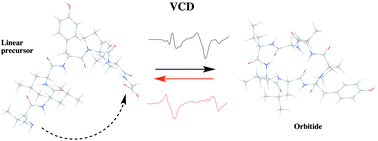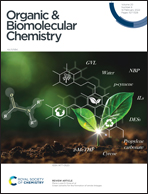Conformational preferences induced by cyclization in orbitides: a vibrational CD study†
Abstract
Orbitides are bioactive head-to-tail natural cyclic peptides from plant species. Their bioactivity is intrinsically related to the main conformations adopted in solution, whose correct characterization represents an important bottleneck for medicinal chemistry applications. To date, NMR spectrosocopy has been the most frequently used technique to assess the secondary structure of orbitides. Despite the amount of structural information commonly available from NMR, its time scale frequently results in a limited conformational ensemble with a single mean structure, which may not represent the bioactive conformation. Additionally, problems with inter-residue NOE/ROE signals can reduce the accuracy and confidence of the 3D assignments. Vibrational circular dichroism (VCD), on the other hand, has been demostrated as a powerful tool to probe the stereostructure of chiral molecules, including peptides and proteins, with enhanced sensitivity to individual conformations in the condensed phase. Herein, we present the first VCD stereochemical investigation of orbitides. By combining IR/VCD experiments in ACN-d3 and ACN-d3/D2O mixtures with DFT calculations in different levels of theory we were able to determine the solution-state conformational behavior, as well as the main structural restraints induced by cyclization, of the seven-residue orbitide pohlianin A and its linear precursor. VCD results indicated inverse γ-turns as the most prevalent structural motif for the linear precursor in partially aqueous solution, while type I and type VI β-turns were induced by the cyclization process, along with some classic γ-turns. In addition to the conformation of the cyclic peptide already described from NMR data, two previously unidentified conformations with distinct secondary structures were found to significantly populate the sample. This conformational discriminatory power of VCD for both linear and cyclic peptides in different solvent systems may lead to more accurate structural characterization of turn-rich peptidic natural products and help the design of conformationally-tailored peptides for more precise structure–activity relationship results.

- This article is part of the themed collection: Mechanistic, computational & physical organic chemistry in OBC


 Please wait while we load your content...
Please wait while we load your content...